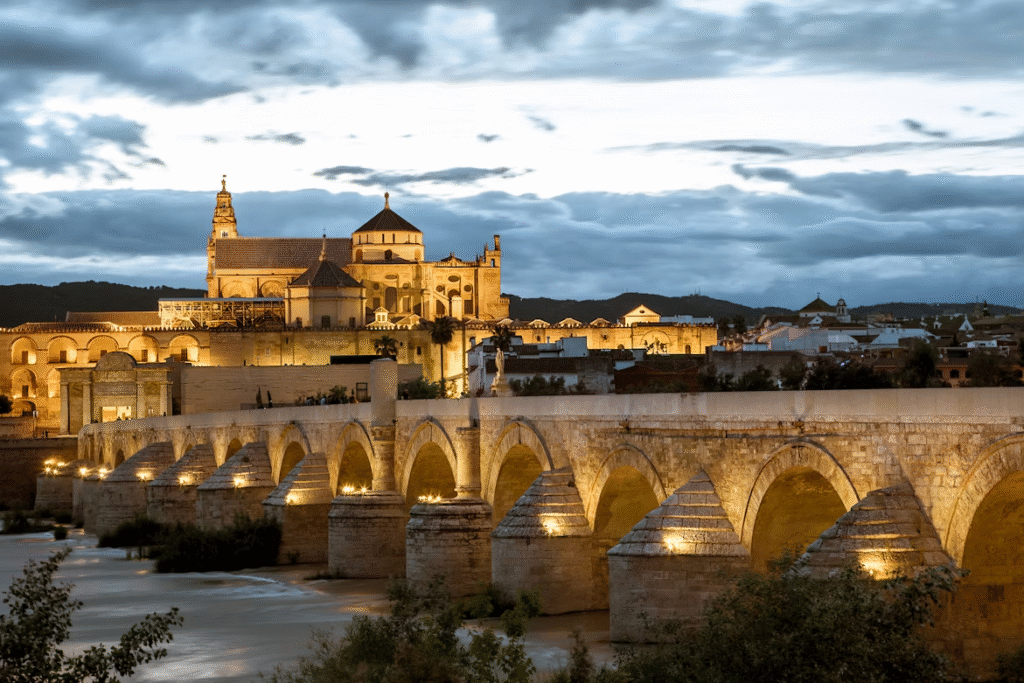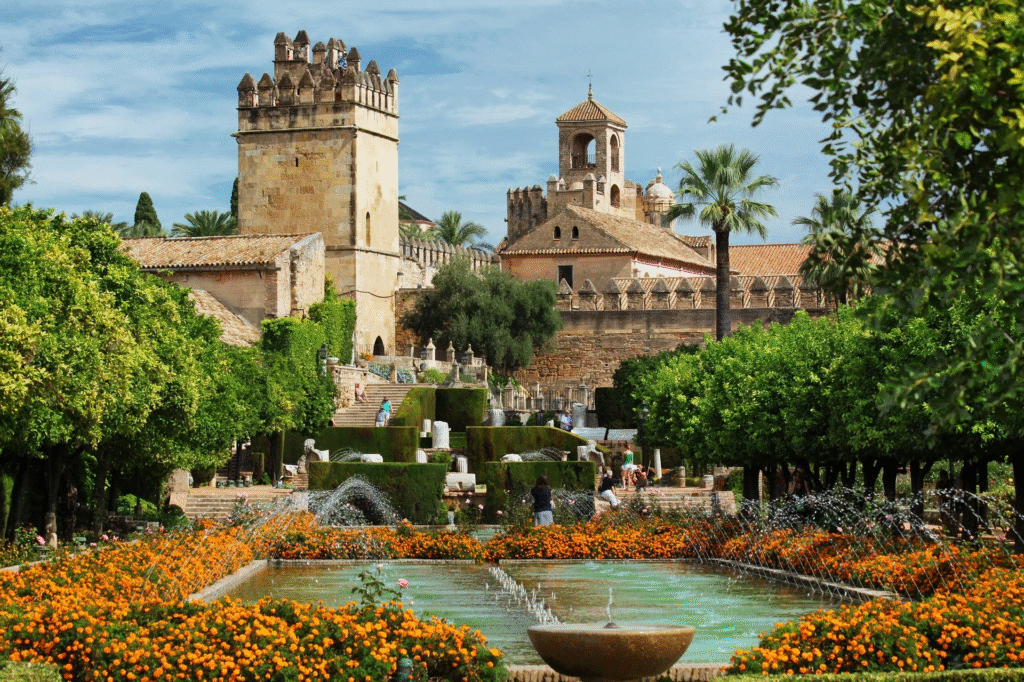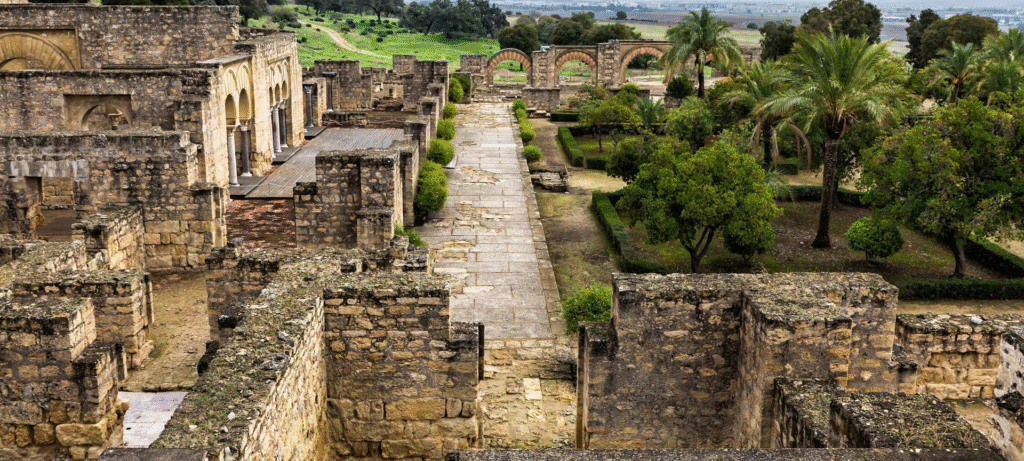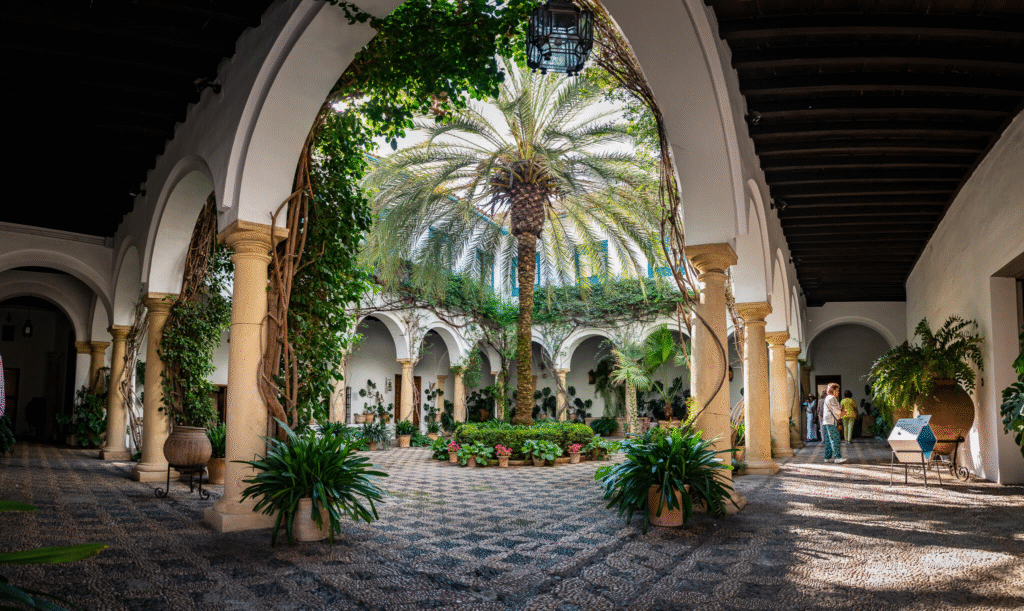Cordoba is one of those Andalusian cities in Spain that packs a ton of history and culture in one place. The only bad thing about Cordoba is that it can get hot in the summer and doesn’t have a beach. In the 10th century, it was the biggest city in Western Europe with nearly half a million people living there. Fast forward to today, it is a city where you can walk through thousands of years of history in just one afternoon. You have Roman ruins, Islamic architecture, Jewish heritage, and Christian landmarks all blending. So, it’s hard to answer what to do in Cordoba Spain because of all this.
Check this article out, too: 7 Day Seville Itinerary: Your Week in Seville
When people think of Andalusia and create an Andalusia travel itinerary, cities like Seville and Granada often grab the spotlight. But if you are planning a trip through southern Spain, Cordoba should be at the top of your list. The city is known worldwide for the Mezquita, the Mosque-Cathedral, but there is so much more to explore. After a ton of articles on Seville as the Andalusia’s capital, I wanted to explore what to do in Cordoba Spain. Give you a rundown of other possibilities that are within an hour’s distance from Seville.

Discover What to Do in Cordoba Spain: An Unforgettable Journey
Cordoba should be just more than a random stop in your Andalusia travel itinerary or a day trip from Seville. You should really get yourself some time to see all the culture. When you are figuring out what to do in Cordoba Spain, it’s good to start with framing your visit. What stands out for you? What should be your focus on the trip? Few cities blend Roman, Moorish, and Christian influences as seamlessly as this Andalusian jewel with a lot of UNESCO World Heritage sites. Which ones will you go for?
Among many other things, Cordoba is only 45 minutes by train from Seville. Super close to doing a quick day trip from Seville and still spending an entire day. Tickets are also about 20 euros. Other than this, Cordoba is like an open-air museum. It’s walkable, easy to reach, welcoming, and packed with historical sites from different empires with different cultures. Cordoba feels more personal. You can sit in a quiet patio surrounded by flowers in the morning and then find yourself under the arches of the Mezquita by lunch.
Best Time to Visit for Fewer Crowds
You need to be aware of two things when you are trying to time your visit to Cordoba: weather and crowds. In summer, the crowds and the weather peak. It’s extremely hot since it’s inland. It can get up to 40 degrees Celsius. Nowadays, it’s getting even hotter. If you want to enjoy the city without sweating through your clothes and waiting in line for each hot spot, spring and autumn are your best bets. April and May are especially nice, not only because of the mild weather but also because the famous patio festival happens in May. Winter is quieter and cheaper. Keep in mind that some patios and outdoor spots lose a bit of their charm when the flowers are gone.
Historic Sites in Cordoba
You’ve probably understood until this point that Cordoba is famous for its historical sights. There won’t be a shortage of these. From Roman engineering to Islamic artistry and Christian rule, the city’s heritage is on full display. That’s why you have to know what sites are worth seeing.
The Mezquita: Cordoba’s Iconic Mosque-Cathedral
The Mezquita is the jewel of Cordoba. Walking inside feels like another world. One of the best preserved historic sights here. Originally built as a mosque in the 8th century, it later became a cathedral after the Reconquista. So you’ll see a cathedral inside a mosque. It’s a UNESCO World Heritage site with 850 columns, which is basically a stone forest.
As you may expect, you need to purchase tickets to enter here. You can either buy it at the door before entering or pre-book your ticket. Depending on the type, the prices range from 30 to 52€. If you pre-book it, you can book a timed-entry ticket, too. It’s a lifesaver if you’re traveling at peak times because you don’t need to wait for the queues. It could even be cheaper if you buy it online. The bell tower tickets are priced differently, but it’s free to enter before 8.30 in the morning.

Alcázar de los Reyes Cristianos
This fortress-palace was once home to Spanish monarchs, including Ferdinand and Isabella, the same duo who sent Columbus off to the New World. The highlight of this palace is the gardens. There are over 150 plant species in the gardens, and it’s spread across 55,000 sq ft. You can even see the irrigation system that still functions from the 14th century. You can climb the tower here, too, and I suggest you do! There are also some areas with glass floor panels where you can see some underground stuff from the Roman times.

Roman Bridge
Want to walk in the footsteps of Romans, Moors, and Hollywood stars? The Roman Bridge has seen it all, from 1st-century chariots to Game of Thrones film crews (you can see it as Volantis’ Long Bridge in season 5). The Roman Bridge has been standing for nearly 2,000 years. Today, it is one of the best spots for sunset views over Cordoba. The bridge connects you to the Calahorra Tower, which has a small museum inside. The tower costs about €4.50, but you may skip this if you have visited one of the other two towers I mentioned.
Medina Azahara
You need to take a short trip to get to this historic landmark. It’s definitely worth it, though. It’s a fortified city-palace hidden in the hills, and it was built in the 10th century. Back in 936 AD, this amazing palace was one of Europe’s most advanced cities. It’s been a UNESCO World Heritage site since 2018. Be ready, as most of the city is in ruins. After Berber factions invaded Cordoba, the city was left in ruins. Even after this, people continued to loot the city for building materials. It was almost erased from existence. That’s why there isn’t much left, but it’s still a magnificent historical landmark. You can get to this palace-city on the special bus that runs from the museum.

Visit and Walk Around Cordoba’s Neighborhoods
In Spanish or Portuguese cities, you will come across the “neighborhood” concept a lot as places to see (eg. my Lisbon Travel Guide has a few). Cordoba also has these amazing little neighborhoods, and you must visit at least one of them. Mostly, it’s about walking around, checking out the famous restaurants or cafes in the area, and some little historical sights. It’s one of the top things to do in Cordoba Spain, I can tell you that.
The Jewish Quarter (La Judería)
The Jewish Quarter is one of the most atmospheric areas in Cordoba. With its narrow lanes, whitewashed walls, and flower-filled balconies, it’s preserved in time. One of the most photographed streets in Cordoba – Calleja de las Flores – is also here. You probably saw it if you researched what to do in Cordoba Spain a little bit. You should go here before 7 am to see it crowd-free and take some amazing pictures. The next best thing is the Zoco artisan market. There are several leather workshops where you can get some solid souvenirs.
This Quarter also has an interesting historical site, Andalusia’s last medieval synagogue, the Cordoba synagogue. It was built in 1315 and is free to explore on weekday mornings. The synagogue is quite small, so take some time to walk around inside.
San Basilio (Alcazar Viejo)
If you like patios and colorful alleys, San Basilio is your place. The district was named after the church in this neighborhood, and it’s famous for the patios and courtyard gardens. This neighborhood is in its best shape in spring, when the flowers are blooming. There is even a Patio Festival in May. During the festival, locals open their doors to visitors so that people can see their gardens, flowers, and plants. As a historical sight, Puerta de Seville was the city’s access point, and it was part of the old western walls of the city back in time. Caballerizas Reales are also worth a quick visit.

Santa Marina
In the north of the city, you’ll find Santa Marina, a traditional neighborhood that was built after the conquest in the 13th century. The name of the neighborhood comes from the Church of Santa Marina in the area. One interesting fact about the Santa Marina neighborhood is that it’s known as the birthplace of bullfighting. You’ll even find a statue of a famous bullfighter, Manolete, in front of the church. There is a tower here, too, (like many other palaces in Cordoba) that was built in the 15th century. It was part of the city’s wall, but it was later used as a prison for the nobility.
Activities in Cordoba
You have to switch from seeing to doing, right? Luckily, Cordoba has some solid activities to do, and it’s not so much that you get lost in the opportunities. You’ll enjoy your time with these if you want to figure out what to do in Cordoba Spain beyond museums and historical sights. You can feel the city in a few hours with these.
Patio Walk
In the previous chapter, I mentioned San Marina, the neighborhood filled with patios. This is not the only neighborhood, though. Many smaller areas and streets have cute patios. Take an ice cream (or coffee) and walk around the city, find these patios, look up, and enjoy your time. Each patio generally has different flowers, plants, or something cute. Some doors stay open in the morning, especially in spring, and you can peek in respectfully.
Walking Tours
Like in many other cities, there are some walking tours in Cordoba, too. This is great because Cordoba is a small city, and you can see the entire city on foot if you know where to go. These tours are generally free, and you need to tip at the end as a gesture. I recommend it because the city is walkable, and if the weather is not hot (if you’re not there in July or August), it makes it a perfect activity in Cordoba. If you prefer to explore independently, do a simple loop, from Mezquita to Calleja de las Flores to the bridge, then back through Plaza del Potro. Evening walking tours are great in summer, the heat drops, the stones glow, and the crowds thin out.
Eat and Drink at Mercado Victoria
Of course, Cordoba has its own market! It’s a lively area with a lot of food, dessert, and drink options. Great spot for a quick lunch and a walk around. Try local bites like salmorejo, flamenquín, and croquetas, then pair them with a cold beer, a glass of Montilla-Moriles wine, or a classic tinto de verano. Prices are fair, the choice is wide, and it works for mixed groups because everyone can grab what they like.

Palacio de Viana: 12 Patios in One
Palacio de Viana is a quiet mansion with twelve patios. This Renaissance palace hides these themed courtyards behind its walls. It’s closed on Mondays, and you need to buy a ticket when it’s open. The gardens are peaceful, the tiles are photogenic, and the whole place feels like a calm break from the city. It is a short walk from the Jewish Quarter, and the ticket includes access to the house and patios.

Relax at Hammam Al Ándalus
Hammam is a special experience and a cultural artifact left from the Islamic times in Cordoba (or this part of Spain). It’s the perfect place if you are tired from all the walking and want to rest. Imagine soaking in warm waters under candlelit arches to rest. There are traditional Arab baths, thermal pools, cool pools, a sauna, and massages (optional, but you need to pay extra if you want). Book ahead, bring swimwear and a towel, and expect a quiet, slow atmosphere.
Practical Tips for Visiting Cordoba
Last but not least, here are some practical tips for when you are visiting Cordoba. It’s not all about what to do in Cordoba Spain, you should also know how to do all that! There are a few things to keep in mind, like the best times to visit Cordoba, how to get around, and how long you should stay. You can plan your time better if you know these tips.
Best Time to Visit Cordoba
Aim for spring or autumn if you can. May is the sweet spot for weather and festivals, and the famous Patios Festival usually runs in early to mid-May each year. That means flowers, open courtyards, and much more to see during the day and evenings. Avoid July and August if you hate heat, because the city gets very warm, and walking at midday becomes tiring. Plan for early mornings and late afternoons if you must travel in summer.
Getting Around
Cordoba is compact and very walkable. The old town is best when you walk it. Don’t rent a car because the roads are narrow and not the best; use taxis or local buses for longer trips. If you have luggage, consider staying near the Mezquita or the train station to cut down on walking time. Renting a bike is an option for flat routes, but the cobbled streets can be bumpy.
Day Trip or Overnight Stay?
Most visitors do this as a day trip, which is doable. You can see almost everything in a day. Some suggest a one-night stay is the perfect thing to do. I partially agree. If you’re there around May or some of the good months, yes, stay for one night. Live that calm evening life with good songs, alcohol, and food. See a good sunset or sunrise.
Conclusion
Figuring out what to do in Cordoba Spain may look easy when you are first planning your Cordoba travel itinerary but it’s not. Yes, it’s a smaller city compared to Seville or Malaga, but Cordoba still has a ton of things to offer. You need to narrow down your list and create a shortlist of things to do in Cordoba. From historic sites like the world-renowned Mezquita to the Jewish Quarter and Roman Bridge, you can spend a minimum of two days seeing only the historic areas. Then you have the patios, hammams, markets, and all these activities to do in Cordoba. I’ve tried to gather the most important, popular, and nice things to do for your Cordoba Spain trip. Try to take a few from each section and create your own Cordoba itinerary.
FAQ
Why is Cordoba a UNESCO World Heritage Site?
The city boasts incredible historical layers, from Roman ruins to Moorish palaces and medieval streets. The Mezquita-Catedral and Medina Azahara are both UNESCO-listed, making them a must-visit for history lovers!
How many days should I spend in Cordoba Spain?
Two to three days are ideal! You’ll have time for the Mezquita, Jewish Quarter, Roman Bridge, and even a day trip to Medina Azahara. Want a relaxed pace? Add an extra day for patios and food tours.
What’s unique about Medina Azahara?
This 10th-century Moorish palace-city was lost for centuries! Now a UNESCO site, its ruins reveal intricate mosaics and grand halls. Take the bus from town—it’s just 8 km away.
Where should I eat traditional Cordoban food?
Try salmorejo (chilled tomato soup) at Bodegas Campos or rabo de toro (oxtail stew) at Casa Pepe de la Judería. For tapas, Taberna Salinas is a local favorite!
Should I book Hammam Al Ándalus in advance?
Definitely! This serene Arab bathhouse fills up fast. Book online for twilight sessions—soaking under starry vaulted ceilings is pure bliss.